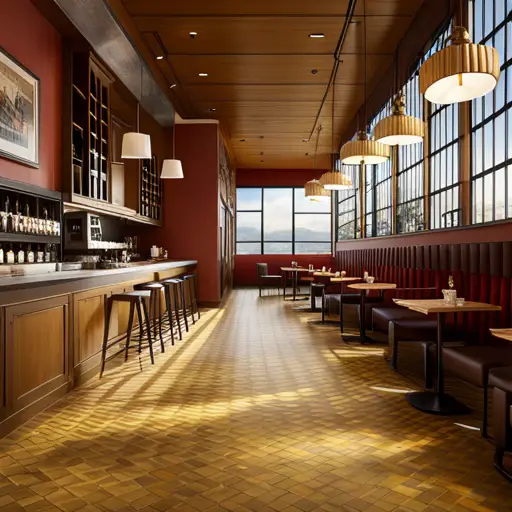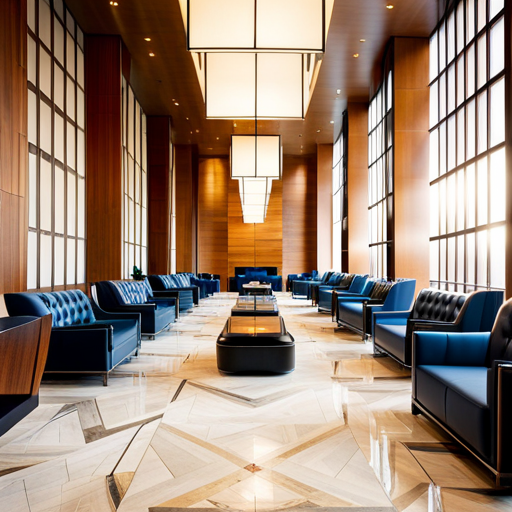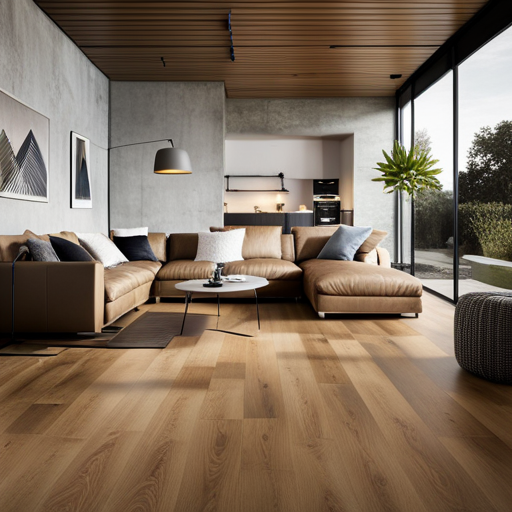The Importance of Flooring in Restaurant Design

Step into any restaurant and the first thing that captures your attention is the flooring beneath your feet. Beyond mere aesthetics, flooring plays a crucial role in creating a welcoming ambiance, ensuring safety, and shaping a restaurant’s brand identity.
From the functional considerations to the visual appeal, the choice of flooring in restaurant design is a multifaceted decision that impacts both the customer experience and the operational efficiency of the establishment.
Enhancing Ambiance
Enhancing ambiance in a restaurant setting often requires careful consideration of the flooring material and design to create a cohesive and inviting atmosphere for patrons. Lighting effects play a crucial role in setting the mood, and the flooring choice can either enhance or detract from this effect.
For instance, a combination of natural light and strategically placed artificial lighting can be complemented by a reflective or glossy flooring surface to create a brighter, more vibrant ambiance. Conversely, a more subdued and intimate setting may call for softer, warmer lighting, which can be accentuated by a darker, matte flooring material.
Furthermore, the acoustic design of a restaurant is another essential aspect that can be influenced by the flooring choice. Hard surfaces such as marble or hardwood can create a lively and energetic atmosphere but may contribute to a noisy environment. Conversely, carpeting or cork flooring can help dampen sound, creating a more intimate and comfortable dining experience.
The careful selection of flooring materials, taking into account both their visual and acoustic properties, is integral to enhancing the overall ambiance of a restaurant.
Safety and Durability
The selection of flooring materials in restaurant design must prioritize safety and durability to ensure a secure and long-lasting environment for both patrons and staff.
When considering safety, slip-resistant flooring is paramount. With the inevitable spills and foot traffic in a restaurant, choosing materials that offer high slip resistance is crucial in preventing accidents and maintaining a secure space.
Additionally, durability is essential for the longevity of the flooring. Restaurant floors endure heavy usage, from constant foot traffic to moving furniture, making it vital to select materials that can withstand such wear and tear without compromising safety.
From a functional standpoint, integrating slip-resistant and durable flooring not only ensures the safety of customers and staff but also minimizes the need for frequent repairs or replacements, saving on maintenance costs in the long run.
Aesthetic considerations need not be compromised when focusing on safety and durability. Many flooring options offer a wide range of styles, colors, and textures, allowing restaurant designers to maintain a visually appealing ambiance while prioritizing safety and longevity.
Ultimately, the thoughtful selection of flooring materials can simultaneously enhance safety, longevity, and visual appeal in restaurant design.
Brand Image and Identity
To convey a restaurant’s brand image and identity effectively, careful consideration of the flooring material’s characteristics and design is crucial. The flooring in a restaurant plays a significant role in shaping brand recognition and influencing customer perception. It is not merely a functional aspect but also an aesthetic element that contributes to the overall ambiance and brand experience. The choice of flooring material, color, texture, and pattern should align with the restaurant’s brand identity, whether it’s a cozy café, a trendy bistro, or a luxurious fine dining establishment.
| Brand Image and Identity | Flooring Considerations |
|---|---|
| Consistency | Ensure the flooring reflects the brand’s consistency and reliability. Consistent flooring throughout different areas of the restaurant creates a cohesive and unified brand image. |
| Visual Impact | The flooring should make a visual statement that resonates with the brand’s personality. Whether it’s sleek and modern, rustic and earthy, or opulent and luxurious, the flooring sets the tone for the dining experience. |
| Maintenance | Choose flooring materials that are not only visually appealing but also practical in terms of maintenance. Cleanliness and upkeep are essential for maintaining a positive customer perception of the brand. |
| Customization | Consider customized elements such as branded floor tiles, patterns, or inlays to reinforce brand identity and create a memorable impression on customers. |
Maintenance and Cleanliness
In ensuring the consistency and visual impact of a restaurant’s brand image and identity, the maintenance and cleanliness of the flooring are integral aspects of its design. Implementing effective cleaning protocols is essential to uphold stringent hygiene standards and create a visually appealing environment for patrons.
The flooring in a restaurant is subject to heavy foot traffic, food and liquid spills, and constant wear and tear, making regular maintenance imperative.
Aesthetic aspects aside, cleanliness is paramount in upholding hygiene standards and ensuring the health and safety of both customers and staff. The choice of flooring material plays a crucial role in the ease of maintenance. For instance, non-porous materials such as ceramic tiles or sealed concrete are easier to clean and less susceptible to staining compared to porous materials like natural stone or wood. Additionally, the use of appropriate floor mats at key areas can help trap dirt and moisture, reducing the risk of slips and falls while also minimizing the spread of contaminants.
Adhering to rigorous cleaning protocols not only preserves the visual appeal of the flooring but also reflects positively on the overall perception of the restaurant, instilling confidence in customers regarding the establishment’s commitment to cleanliness and hygiene.
Functional Considerations
When selecting flooring for a restaurant, it is crucial to prioritize functional considerations that align with both the aesthetic and practical needs of the establishment.
One of the key functional considerations in restaurant design is an ergonomic layout that takes into account the movement of staff and patrons. The flooring should support a layout that enables efficient and comfortable movement, reducing the risk of accidents and fatigue among staff.
Additionally, the flooring material should contribute to the establishment’s traffic flow. This involves selecting durable, easy-to-clean flooring that can withstand high foot traffic without showing signs of wear and tear. A well-designed traffic flow can enhance the overall dining experience by ensuring that patrons can move around the restaurant with ease.
Moreover, the flooring should contribute to the establishment’s aesthetic by complementing the overall design theme. By striking a balance between functionality and aesthetics, the flooring can elevate the dining environment while meeting the practical needs of the restaurant.
Frequently Asked Questions
What Are Some Popular Flooring Trends in Restaurant Design That Can Enhance the Overall Ambiance of the Space?
In restaurant design, popular flooring trends include customizable options and sustainable materials. These trends enhance the overall ambiance by offering creative, functional, and aesthetic flooring solutions that align with the restaurant’s theme and brand identity.
How Can Flooring Choices Impact the Safety and Durability of a Restaurant’s Environment, Especially in High-Traffic Areas?
Flooring choices greatly impact the safety and durability of a restaurant’s environment, particularly in high-traffic areas. Safety measures and durability are key factors in choosing popular flooring trends to create a comfortable and clean ambiance.
How Does the Choice of Flooring Contribute to a Restaurant’s Brand Image and Identity, and How Can It Be Used to Convey a Specific Atmosphere or Theme?
Elevating a restaurant’s brand image, flooring choice plays a pivotal role in creating a distinct atmosphere and theme. It conveys the restaurant’s identity, enhances ambiance, and evokes emotion in customers, making it a crucial branding element.
What Are Some Advanced Maintenance and Cleanliness Practices Specifically Related to Restaurant Flooring, and How Can They Impact the Overall Cleanliness of the Establishment?
Implementing advanced maintenance and cleanliness practices for restaurant flooring is crucial. Regular cleaning, using appropriate products, and addressing any damage promptly can significantly impact the overall cleanliness of the establishment, ensuring a hygienic and inviting environment.
In What Ways Can the Flooring Choices Impact the Functional Considerations of a Restaurant, Such as Noise Reduction, Ease of Cleaning, and Creating a Comfortable Environment for Both Staff and Customers?
Flooring choices greatly impact restaurant functionality. Noise reduction and slip resistance ensure a comfortable environment for staff and customers. Cleaning efficiency is also crucial for maintaining hygiene. Flooring plays a pivotal role in enhancing these functional considerations.
Conclusion
In conclusion, the flooring in restaurant design plays a crucial role in enhancing ambiance. It sets the tone for the overall dining experience and contributes to the success of the establishment.
Additionally, the flooring ensures safety and durability, reflecting brand image and identity. It is important for the flooring to be able to withstand heavy foot traffic and spills, while also aligning with the restaurant’s desired aesthetic.
Moreover, the flooring is essential for maintaining cleanliness. It should be easy to clean and resistant to stains and bacteria, in order to meet health and safety standards.
Lastly, the flooring must also meet functional considerations. It should be slip-resistant to prevent accidents, and provide a comfortable surface for both customers and staff.
As the saying goes, ‘the devil is in the details,’ and the flooring is an essential detail that should not be overlooked in restaurant design.

Rubin Everest, a seasoned expert in the world of flooring, brings a wealth of knowledge and passion to the surface. As the mind behind ebbow.com, Rubin is dedicated to sharing insights on the latest trends, innovative solutions, and expert advice in the realm of flooring. Whether you’re seeking practical tips for installation or design inspiration, Rubin Everest is your go-to source for all things flooring-related, making your journey to the perfect floor an informed and enjoyable experience.





